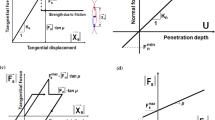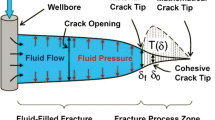Abstract
Fluid flow modeling is a major area of interest within the field of rock mechanics. The main objective of this study is to gain insight into the performance of grout injection inside jointed rock masses by numerical modeling of grout flow through a single rock joint. Grout flow has been widely simulated using non-Newtonian Bingham fluid characterized by two main parameters of dynamic viscosity and shear yield strength both of which are time dependent. The increasing value of these properties with injection time will apparently affect the parameters representing the grouting performance including grout penetration length and volumetric injection rate. In addition, through hydromechanical coupling a mutual influence between the injection pressure from the one side and the joint opening/closing behavior and the aperture profile variation on the other side is anticipated. This is capable of producing a considerable impact on grout spread within the rock joints. In this study based on the Bingham fluid model, a series of numerical analysis has been conducted using UDEC to simulate the flow of viscous grout in a single rock joint with smooth parallel surfaces. In these analyses, the time-dependent evolution of the grout fluid properties and the hydromechanical coupling have been considered to investigate their impact on grouting performance. In order to verify the validity of these simulations, the results of analyses including the grout penetration length and the injection flow rate were compared with a well-known analytical solution which is available for the simple case of constant grout properties and non-coupled hydraulic analysis. The comparison demonstrated that the grout penetration length can be overestimated when the time-dependent hardening of grout material is not considered. Moreover, due to the HM coupling, it was shown that the joint opening induced by injection pressure may have a considerable increasing impression on the values of penetration length and injected grout volume.














Similar content being viewed by others
Abbreviations
- a :
-
Constant joint aperture
- a 0 :
-
Initial aperture under zero normal stress
- a e :
-
Total equivalent aperture
- a i :
-
Local aperture
- I :
-
Grouting penetration length
- I D :
-
Relative penetration length
- I max :
-
Maximum penetration length
- K g :
-
Bulk modulus of grout
- k n :
-
Normal stiffness of joint
- L :
-
Length of circular pipe with fluid flow
- l i :
-
Length of each domain
- n :
-
Number of domains
- p, p g :
-
Grout injection pressure
- p 0 :
-
Domain pressure at previous time step
- p f :
-
Initial fluid pressure
- Q, q :
-
Volumetric injection flow rate
- r :
-
Radius of circular pipe with fluid flow
- t :
-
Grouting time
- t 0 :
-
Characteristic grouting time
- t D :
-
Relative time
- V :
-
Injected grout volume
- V 0 :
-
Domain volume at previous time step
- V m :
-
Mean of domain volumes at the current and previous time step
- w :
-
Width of joint
- W/C :
-
Weight ratio of water to cement
- Z :
-
Half height of grout column
- ∆p :
-
Difference between grout pressure and initial fluid pressure
- ∆t :
-
Time step
- ∆u n :
-
Aperture increment
- θ :
-
Dimensionless relative time
- (μ), μ g :
-
Viscosity of grout
- σ t :
-
Tensile strength
- (τ), τ 0 :
-
Yield shear strength
References
Barton N, Bandis S, Bakhtar K (1985) Strength, deformation and conductivity coupling of rock joints. Int J Rock Mech Min Sci 22(3):121–140
Broch E (2007) Use of the underground in the city of Trondheim, Norway. In: The 11th ACUUS conference: expanding the Frontiers, September 10–13, Athens, Greece
Carter TG, Dershowitz W, Shuttle D, Jefferies M (2012) Improved methods of design for grouting fractured rock. In: Proceeding of 4th international conference on grouting and deep mixing, vol 2. ASCE, New Orleans, pp 1472–1483
Dershowitz W, Deo T, Uchida M, Hermanson J (2007) Analysis of groundwater inflow control by grouting using the discrete fracture network method. Felsbau 25(4):34–41
Fujita T, Shinkai F, Nobuto J (2012) Fundamental study on a grout penetration model for a HLW repository. J Energy Power Eng 6:1191–1203
Ghafar AN, Mentesidis A, Draganovic A, Larsson S (2016) An experimental approach to the development of dynamic pressure to improve grout spread. Rock Mech Rock Eng. doi:10.1007/s00603-016-1020-2
Gustafson G, Stille H (1996) Prediction of groutability from grout properties and hydrogeological data. Tunnel Undergr Space Technol 11(3):325–332
Gustafson G, Stille H (2005) Stop criteria for cement grouting. Felsbau 23:62–68
Hassler L, Hakansson U, Stille H (1991) Computer-simulated flow of grouts in jointed rock. Tunnel Undergr Space Technol 7(4):441–446
Houlsby AC (1990) Construction and design of cement grouting. Wiley, New York
Itasca Consulting Group Inc. (2014) Universal distinct element code, UDEC version 6 user’s guide. Minneapolis
Kobayashi S, Stille, H (2007) Design for rock grouting based on analysis of grout penetration. In: Verification using Äspö HRL data and parameter analysis (No. SKB R-07-13). Swedish Nuclear Fuel and Waste Management Company, Stockholm, Sweden
Kobayashi S, Stille H, Gustafson G, Stille B (2008) Real time grouting control method. In: Development and application using Äspö HRL data (No. SKB R-08-133). Swedish Nuclear Fuel and Waste Management Company, Stockholm, Sweden
Kobayashi S, Soya M, Takeuchi J, Nobuto A, Nakaya A, Okuno T, Shimada S, Kaneto T, Majima T (2014) Rock grouting and durability experiments of colloidal silica at Kurashiki underground LPG storage base. In: Rock engineering and rock mechanics: structures in and on rock masses, proceedings of EUROCK 2014, Vigo, Span, 26–28 May 2014, pp 1027–1034
Lee JW (2017) Performance analysis on the design parameters of viscous fluid penetration in rock joint. Ms.C. thesis, Sejong University, Seoul, Korea
Lee JW, Kim HM, Lee HB, Oh TM, Park ES (2017) Experimental and numerical analysis of grout penetration in rock joints. In: 2017 ISRM young scholar’s symposium on rock mechanics (YSRM 2017) & 2017 international conference on new development in rock mechanics and geotechnical engineering (NDRMGE 2017), May 10–13, 2017, Jeju, Korea
Lombardi G, Deere D (1993) Grouting design and control using the GIN principle. Int water power dam constr 45(6):15–22
Olsson R, Barton N (2001) An improved model for hydromechanical coupling during shearing of rock joints. Int J Rock Mech Min Sci 38:317–329
Rafi JY, Stille H (2015) Applicability of using GIN method, by considering theoretical approach of grouting design. Geotech Geol Eng 33(6):1431–1448
Rahmani H (2009) Estimation of grout distribution in a fractured rock by numerical modeling. Appendix A: Derivation of The Bingham Fluid Equations, Master Thesis, The University of British Columbia, May 2009, pp 118–123
Renshaw CE (1995) On the relationship between mechanical and hydraulic apertures in rough-walled fractures. J Geophys Res Solid Earth 100(B12):24629–24636
Saeidi O, Stille H, Toradi SR (2013) Numerical and analytical analyses of the effects of different joint and grout properties on the rock mass groutability. Tunnel Undergr Space Technol 38:11–25
Sui W, Qu H, Gao Y (2015) Modeling of grout propagation in transparent replica of rock fractures. Geotech Test J 38(5):765–773
Tani ME (2012) Grouting rock fractures with cement grout. Rock Mech Rock Eng 45(4):547–561
Wallner M (1976) Propagation of sedimentation stable cement pastes in jointed rock. In: Rock mechanics and waterways construction, University of Aachen, BRD, pp 449–461
Wilkinson WL (1960) Non-Newtonian fluid: fluid mechanism mixing and heat transfer. Pergamon Press, London
Zhang D, Fang Q, Lou H (2014) Grouting techniques for the unfavorable geological conditions of Xiang’an subsea tunnel in China. J Rock Mech Geotech Eng 6(5):438–446
Acknowledgements
We sincerely thank anonymous reviewers and the Editor for their careful reading and critical comments as well as valuable suggestions to improve the quality of this paper considerably. This research was supported by the Basic Research Project of the Korea Institute of Geoscience and Mineral Resources (KIGAM) that is funded by the Ministry of Science and ICT of Korea. First author was supported by the Basic Science Research Program through the National Research Foundation of Korea (KRF) that is funded by the Ministry of Science and ICT of Korea (2017R1A2B4002280).
Author information
Authors and Affiliations
Corresponding author
Rights and permissions
About this article
Cite this article
Kim, HM., Lee, JW., Yazdani, M. et al. Coupled Viscous Fluid Flow and Joint Deformation Analysis for Grout Injection in a Rock Joint. Rock Mech Rock Eng 51, 627–638 (2018). https://doi.org/10.1007/s00603-017-1339-3
Received:
Accepted:
Published:
Issue Date:
DOI: https://doi.org/10.1007/s00603-017-1339-3




